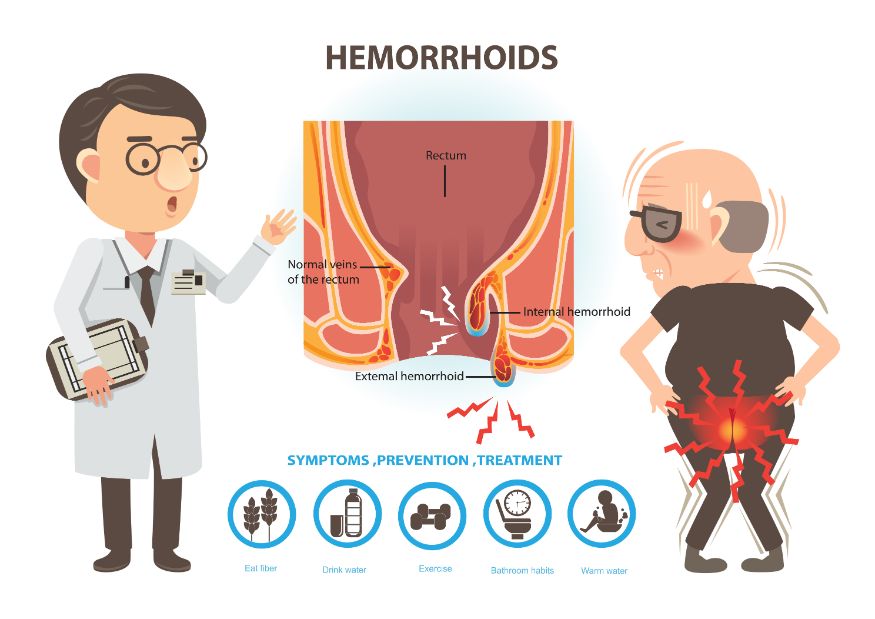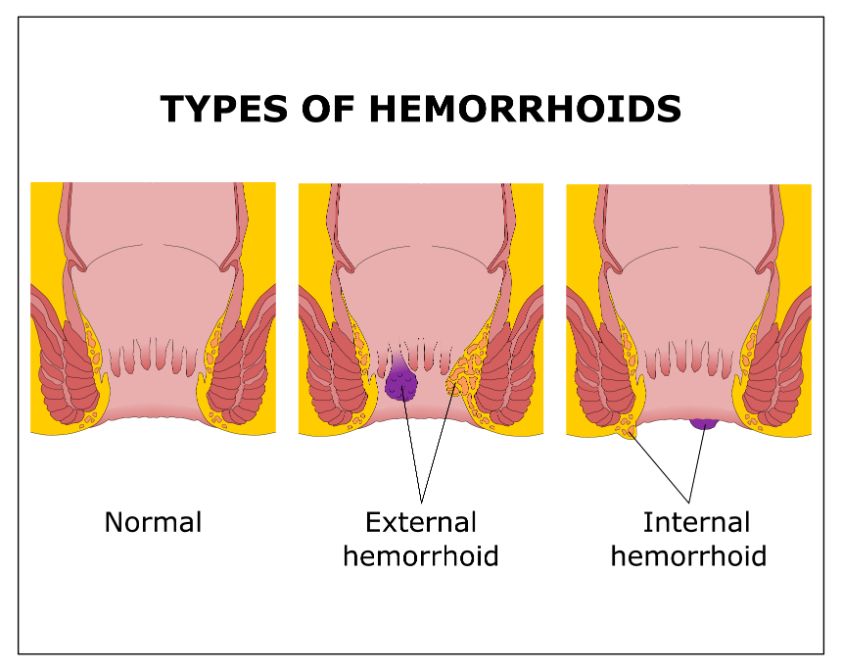Hemorrhoids Treatment in Dubai, Abu Dhabi and Al Ain
Hemorrhoids, also known as Piles, are blood vessels that are located in the smooth muscles of the walls of the lower rectum and anus. When these blood vessels are swollen in the lower rectum and anus, they stretch causing the veins to bulge and get irritated, especially during bowel movements.
Hemorrhoids can be seen once they are swollen in the form of internal or external hemorrhoids and occur as a result of several reasons, the most common of which is chronic constipation. Hemorrhoids can cause severe pain, itching, and discomfort when sitting. Several pharmacological, surgical, and other medical interventions are available to treat hemorrhoids.
Our experienced proctologists provide treatment plans that suit the severity of each condition. In mild cases, they may use topical medications and balanced diet plans to help to alleviate symptoms. In complex or severe cases, they can perform surgery to remove the hemorrhoids and repair any damaged tissue.
Contact our team to book your personalized treatment today.

Types of Hemorrhoids (Piles)
- External hemorrhoids: Rectal bleeding resulted from the rupture of a blood vessel beneath the skin surrounding the anus. It causes itching, pain and swelling around the anus, and blood in the stool.
- Internal hemorrhoids: They occur inside the rectum. They are not always visible as they are deep inside the anus. Internal hemorrhoids are not usually serious and tend to go back inside on their own, but if they don’t, they can be gently pushed back into place.
- Prolapsed hemorrhoids: Prolapsed hemorrhoids appear when the internal hemorrhoids swell and stick to the anus.
- Thrombosed hemorrhoids: This type of hemorrhoids has no blood flow due to blood clots. Thrombosed hemorrhoids can be quite painful and appear as lumps or swelling around the anus.

Causes of Hemorrhoids
The veins surrounding the anus often stretch when under pressure and may bulge or swell with blood, resulting in an increase in their size. The presence of hemorrhoids is normal human anatomy and they only become prominent when they swell and cause problems. The increase in pressure may stem several factors such as:
- Overall weakness of connective tisue
- Straining during bowel movement
- Chronic constipation
- Sitting on the toilet seat for long periods as a result of constipation
- Bowel movement disorder, such as chronic diarrhea or constipation
- Obesity
- Pregnancy
Hemorrhoids are the most common cause of rectal and anal complaints. The most common symptoms include:
- Swollen lumps around the anus
- Irritation or itching in the anal area
- Painless bleeding during bowel movements
- Leakage of stool outside the anus
- Pain and discomfort
It’s very important to remember rectal bleeding or blood in the stool is never normal, although it may appear benign at the beginning, it could be a sign of something life-threatening.
When an internal hemorrhoid becomes irritated, it causes swelling, this does not cause pain as there are no pain fibers attached to the veins above the pectinate line. The passing of hard stool can scratch the lining of the hemorrhoid triggering painless bleeding. The swollen hemorrhoid can cause spasm of the muscles that encircle the rectum and anus resulting in pain of the hemorrhoids that protrude or prolapse through the anus. Internal hemorrhoids can result in clots causing severe pain.
External hemorrhoids are different from Internal hemorrhoids as they are covered by “regular skin” and have pain fibers linked to them. A thrombosed external hemorrhoid occurs when an underlying vein within the hemorrhoid clots off causing severe pain from the stretching of the skin that is covering the hemorrhoid. A hard-painful lump can be felt at the entrance of the anus.
The diagnoses of hemorrhoids are determined by taking into account the patients’ medical history and performing physical examination. The history will determine the cause of hemorrhoids such as constipation, straining whilst on the toilet or passing of hard stool. The physical examination is performed to establish the diagnosis and includes a rectal examination where a finger is used to feel for abnormal lumps. In the case of severe hemorrhoid symptoms, an endoscope may be considered. It’s a procedure where a lubricated tube is inserted into the anus to produce digital images of the anus.
We have a wide range of further diagnostics should they be required including:
- Video Proctosigmoidoscopy & Fistuloscopy: This tool is used to see further inside the rectum or fistula.
- Trans-Rectal High-Resolution Ultrasound: Also referred to as TRUS and is often used to determine abnormalities in the rectal muscles.
- MRI, labs and pathology and more: Our state-of-the-art diagnostic equipment gives many options to physicians in order to diagnose and personalize a treatment plan suited to your health problem.
Once hemorrhoidal symptoms develop, there are several treatment options which can be used. The treatment method is dependent upon the situation and severity of symptoms experienced; the options are as follows:
- Hemorrhoidectomy: This procedure removes external hemorrhoids that can’t be treated with non-surgical methods. The physician will cut the tissue that causes bleeding under anesthesia. This procedure is very effective to treat advanced cases of external hemorrhoids.
- Hemorrhoid stapling: Is used to treat prolapsed hemorrhoids by fixing them back inside the rectum with staples. Stapling is less painful and requires less recovery time than hemorrhoidectomy.
- Rubber band ligation: A procedure that is used to treat internal hemorrhoids by wrapping one or two tight bands around the base of the hemorrhoid to stop its circulation. The hemorrhoid withers and falls off within 4-7 days.
- Sclerotherapy: During this procedure, the doctor injects a chemical solution into the hemorrhoid tissue to shrink it. Although this does not cause any pain, it may be less effective than the rubber band ligation.
- Coagulation: An infrared laser is used, heat or cold rays shrink the hemorrhoids. It can be done at the physician’s practice with minimal discomfort.
- Non-surgical treatment: Hemorrhoids can be treated with over-the-counter medicine including lotions, gels, creams, anti-inflammatory painkillers and by diet.
Its estimated 75% of people suffer from hemorrhoids at some point in their life, with the risk increasing between the ages of 45 and 65. Hemorrhoids can be prevented, in several ways. A diet high in processed foods is more likely to cause hemorrhoids, a low fiber diet can leave a person constipated which can cause hemorrhoids. Constipation leads to straining on the toilet and aggravates hemorrhoids by the passing of hard stools irritating the swollen veins. It’s important to consume drink plenty of water, fresh fruits, vegetables, cereals and whole grains to minimize the risk of developing hemorrhoids.
To book a consultation with our specialist proctologist or for more information, call us toll-free on 800 (NOVO) 6686 or click the live chat icon at the bottom of the screen.
